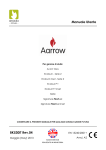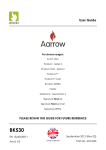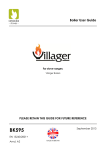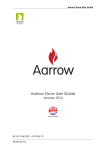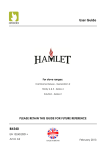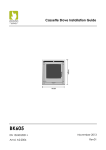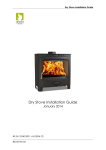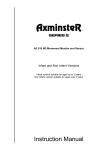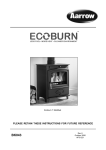Download Aarrow EcoBurn AFS1221 User guide
Transcript
DEFRA Stove Installation and User Guide For stoves ranges: Aarrow DEFRA Signature DEFRA Ecoburn DEFRA Solution DEFRA PLEASE RETAIN THIS GUIDE FOR FUTURE REFERENCE BK575 EN 13240:2001+ Amd. A2:2004 February 2013 More than 20 years experience has been put into the development of our stoves to ensure ultimate performance and years of trouble free use and enjoyment. Every detail of the stove has been carefully designed and engineered which is why we are so confident in the reliability of our products. Should you have any questions about our stoves that are not covered by this manual, please contact the Arada retailer in your area, or call our technical support department on 08448 567181 . All Arada stoves are tested to European Standard EN 13240. WARNINGS It is a legal requirement that the installation of all new or replacement wood fuel heating appliances must obtain building control approval from your local authority. Please consult health and safety guidelines for advice on handling heavy and/or large items. Any manufacturer’s instructions must not be taken as overriding statutory requirements. The installation must comply with all current building regulations and any additional local ordinances. Installation work must be carried out by a qualified heating engineer, affiliated to a government approved competent persons scheme such as operated by HETAS. During installation ensure that adequate precautions are taken to avoid unnecessary risk to yourself or any householder. In particular the danger from the caustic nature of fire cement should be avoided by using these accepted methods; wear gloves when handling fire cement and goggles when chiselling or looking up chimneys. If in doubt, contact HETAS Ltd. T: 0845 634 5626 W: www.hetas.co.uk A fireguard conforming to BS 8423:2002 should be used in the presence of children and old or infirm people. Do not use aerosol sprays or any other flammable materials near the appliance when in use. Arada Ltd will not be responsible for any consequential or incidental loss or injury however caused. Arada has a policy of continuous product development and therefore we reserve the right to amend the specification without prior notice. Due to printing cycles, items or options may be described before they are generally available or after they have ceased. 2 DEFRA Stove Installation and User Guide INSTALLAITON INSTRUCTIONS HEARTH AIR FOR COMBUSTION The stove should be installed on a floor with adequate load bearing capacity. If the existing construction does not meet this prerequisite, suitable measures (e.g. load distributing plate) should be taken to achieve it. All stoves require ventilation to burn safely and correctly. There are requirements that need to be met when installing a stove, such as allowing for the permeability of the house (air permeability is the general seepage of air into the house via air vents, doors and windows etc.). Ideally, the appliance should stand on a constructional hearth of non-combustible materials not less than 125mm (5”) thick conforming to Building Regulations. Dimensions of the hearth should project at least 225mm (9”) forward of the front of the appliance and 150mm (6”) at the sides. The surface of the hearth should be free of combustible materials. Certain stoves manufactured by Arada are suitable for installation on a non-combustible 12mm hearth such as glass. Please consult the technical table found at the rear of the user guide for a list of suitable models. COMBUSTIBLE MATERIALS Please view the technical data table in the rear of the user guide and observe the minimum distance to combustible materials, which is applicable to your stove model. Ideally, adjacent walls should be of suitable non-combustible construction, preferably brickwork. In large fireplaces take care that any supporting beam is protected by a 13mm (0.5”) sheet of Masterboard or Superlux spaced 12mm (0.5”) off the surface with strips of non-combustible material. Make sure that there is a gap between an un-insulated flue system and any combustible material. This gap must be at least 3X the outside diameter of the flue pipe, or 1.5X the flue diameter to non combustible surfaces. DEFRA Stove Installation and User Guide There must always be a permanent means of providing air for combustion into the room in which the stove is installed. For guidelines on required ventilation sizes please refer to the ‘HETAS Guide’ which can be found on HETAS’ website. The positioning of any air vent must be so that it cannot be liable to blockage or obstruction. The fitting of an extractor fan in the same room as the stove, or an adjacent room is not permitted. FITTING THE FLUE OUTLET The flue outlet spigot may be fitted onto the stove, but will not be fully tightened. The flue outlet assembly can be orientated for top or rear flue exit as shown in fig 1a & b on page 4. The outlet pipe flange is pre fitted with a gasket rope seal. Additional fire cement may be added if required. The flue pipe assembly is secured in place with four M5 bolts (supplied). Tighten bolts diagonally and evenly to ensure full compression of the gasket but do not over tighten. Place appliance on the hearth and make sure that it is level and does not rock. Connect the chimney ensuring all joints are 3 INSTALLATION INSTRUCTIONS sealed with fire cement. Note : The flue pipe must be fitted inside the outlet spigot. Failure to do so could result in the spillage of condensation running down the flue, (see fig.1c) FIREBOX LINER PANELS Arada DEFRA stove uses firebox liner panels at both sides of the stove. The throat plate is not supported by these liners, however the throat plate must be installed before the liners can be fitted, and the liners removed before the throat plate can be removed. To remove / fitting the liners Open the fire door. Remove the wood burning tray Remove the lower side liners, carefully allowing the upper side liners to slide down to the landing plate Remove the upper side liners Replacing or fitting the liners is the reverse of this procedure Note : Cracking of the liner panels does not effect the normal use or efficiency of the stove. FITTING THE THROAT PLATE ADJUSTING THE SELF LEVELLING FEET IF APPLICABLE Adjustment is as follows: Position the stove on the hearth into its final resting place. On the rear leg of the stove, loosen the pozi screw, and rotate the inner ‘cam’ shaped levelling foot until this touches the hearth. Re-tighten the pozi screw. Check the stove is level with a spirit level. 4 Repeat for the other rear leg. This must be carried out with the wood burning tray and side liners removed. DEFRA Stove Installation and User Guide INSTALLATION INSTRUCTIONS All images below are cut-away for clarity 1. Insert throat plate assembly into the fire box and manoeuvre so that the throat plate drops into the landing plate cutouts. 2. Raise the throat plate assembly vertically out of the landing slots ensuring the front edge remains behind the front edge of the air wash lip, see fig 4. 3. Hook the throat plate ‘T’ cut-out onto the support hanger and push back to slide onto the secondary air tube; the wood tray will hold the bottom edge into the correct position. FLUES AND CHIMNEYS The flue draw is critical on any installation and should be checked to ensure that it matches what is specified. If it is higher than recommended, provisions must be made to correct the over draw. The draw can vary in different weather conditions and the customer should be made aware of this. Failure to correct an over drawing flue will invalidate the warranty. The stove must be connected to a suitable and efficient flue so that products of combustion (fumes) from the stove are expelled to the outside air. To ensure a good up draught it is important that the flue gases are kept warm and that the flue size suits the stove. The termination of the outlet at the top of the flue also needs to comply with Building Regulations. The minimum effective height of the flue must be at least 4.5 metres from the top of the stove to the top of the flue outlet. When warm the flue draught should be between 0.1 to 0.2 mb. A chimney may comply with regulations but could still be subject to down draught and similar problems. A chimney terminating above the ridge level is generally less likely to suffer such problems. GRATE BARS In a multi fuel stove, the grate comprises of a series of cast iron grate bars seated on a pair of combs. All bars in the grate are identical. The bars should be seated with every other bar rotated 180 degrees, so the ends marked ’H’ and ’L’ alternate on each comb. DEFRA Stove Installation and User Guide If a new chimney is being built / installed it should fully comply with the relevant Building Regulations that specify the requirements for solid fuel burning installations. The flue and chimney installation must be carefully checked by a competent person before fitting the stove to ensure it is suitable and will work safely. If the chimney is old (ie: built of brick or stone without a liner) or being opened up for reuse additional checks and smoke testing as described in Appendix E of the Approved Document J 2002 Edition should also be carried out to ensure the flue and chimney are 5 INSTALLATION INSTRUCTIONS in good operating condition. Check the existing flue is in good condition with suitable access for collection and removal of debris. If the flue size is more than 225mm (9”) diameter or 200mm (8”) X 200mm (8”) square, a suitable lining of 150mm (6”) diameter should be fitted. Approved Document J 2010 allows for the use of a 5” liner / flue for wood burning when a stove that is DEFRA exempt is installed. This is as a result of the very clean burning nature of DEFRA exempt stoves, when operated in strict accordance to the user manual. If the DEFRA exempt stove is replaced at any time with a NON DEFRA exempt stove, the liner / flue must be changed to a 6” diameter liner to conform to Building Regulations when burning wood. the appliance and up the chimney. If this is the case we recommend the fitting of a draught stabiliser in preference to a flue damper, in the interest of safety and efficiency. The installer should comply with Building Regulations requirements in respect of providing a Notice Plate giving details on the chimney, flue lining, hearth and fireplace installation. FINAL CHECK LIST Before handing over the installation to the customer it is a requirement under Document J (of the Building Regulations for England & Wales) that the appliance is lit and the functioning of the chimney system is checked for satisfactory operation. Be sure that the chimney is operating and all smoke and fumes are vented to the atmosphere through the chimney terminal. Details of suitable linings for use with wood fuel are given in the HETAS guide that can be viewed on their website at www.hetas.co.uk. Check all joints and seals. Clean the outside of the appliance to prevent any stains becoming burnt on. It is also important that suitable flue pipe, complying with the Building Regulations, is used to connect the stove to the flue in the chimney, and that suitable access is provided into the flue for regular inspection and sweeping of the flue ways other than through the appliance (e.g. wherever possible a soot door or access through register plate). Check the flue draught which should read 1 - 2mm, or 0.1 - 0.2 mbar. For a registered competent persons scheme, such as HETAS, please complete a Certificate Of Compliance, which is used for checking and reporting the installation as imposed by the Government. Explain the controls and operation of the appliance to the customer. Ensure a Carbon Monoxide alarm is fitted. This must be between 1m to 3m of the appliance, and approximately 150mm below the ceiling level. A fireguard conforming to BS 8423:2002 should be used in the presence of children and old or infirm people. This should be a double skin stainless steel flexible liner that is independently certified for use with solid fuel. Chimneys should be as straight as possible. Horizontal runs should be avoided except where the rear outlet of the appliance is used, in which case the horizontal section should not exceed 150mm (6”) in length. If the stove appears to be working hard but produces very little output to the room it is likely that excess draw is present in the chimney, and that heat is being sucked out of 6 DEFRA Stove Installation and User Guide USER GUIDE FUEL TYPES Paper The most efficient use of this appliance is with the fire door(s) closed at all times, apart from re-fuelling (when alight) or cleaning (when cold). Paper will burn successfully. Burn dry paper only or chimney damage will occur. Never leave the appliance unattended for an extended length of time with the door(s) open. Please contact Arada Ltd for further details and advice on the use of other fuels. If this is the case, a spark guard must be used and the operating efficiency of the appliance will decrease. Wood Any type of wood is suitable provided it is well seasoned and has a moisture content below 20%. This usually implies that the timber has been suitably stored to allow moisture to evaporate for at least nine months in the case of soft woods, and at least eighteen months in the case of hard wood. We recommend that for general burning, wood should be split into logs of no more than 100mm(4”) diameter. WARNING : Wet wood must not be used as this will greatly contribute to the creation of tar and creosote which may, in extreme cases, run down the chimney in liquid form. This will seriously damage both the chimney and the appliance, and increase the risk of a chimney fire. Please Note : If you have sticky tar inside the appliance or chimney your wood is ‘Green’ or too wet. Please Note : The burn classification for all appliances in these instructions are classed as intermittent use. DEFRA Stove Installation and User Guide WARNING : Never burn plastics, household waste or liquid fuels in your stove Lighting the fire Prior to lighting the stove for the first time, check with the installer that: • Installation and all building work is complete. • The chimney is sound and has been swept and is free from obstruction. • Adequate provision for combustion air has been made. • That Building Regulations and any local by laws have been followed during installation. See installation section of this manual. • All firebox liner panels and throat plate are in place. • That the chimney draw has been checked and is within specification. With the chimney warm, the draught should be between 1-2 mm water gauge or 0.1 to 0.2 mbar. WARNING : An over drawing chimney can cause over firing, resulting in damage to the appliance. Ensure that you have read and understood these instructions before lighting the fire. Always wear suitable protective fire gloves when refuelling your stove. 7 USER GUIDE Important reminders for the user. 1. Take care to insure against blocking or obstructing the permanent air ventilator fitted to supply combustion air for the appliance. 2. Do not install an extractor fan in the same room as the appliance or a room adjoining the same room. If the installer considers this unavoidable refer to Approved Document J Section 1, Paragraphs 1.20 & 1.23 for guidance HETAS Approval only covers the use of wood on the appliance and does not cover the use of other fuels either alone or mixed with other fuels, nor does it cover instructions for the use of other fuels. Clean Burning of Wood In order to burn wood cleanly, in accordance with the DEFRA exception certificate applicable to this stove, it is important that the Ignition and Re-fuelling instructions are followed carefully. embers the “Ignition Sequence” is complete and re-fuelling for normal use can commence. The purpose of these ignition instructions (lighting from cold) is to ensure that both the stove and chimney are heated to full running temperature as quickly as possible so avoid smoke emissions during subsequent re-fuelling. Re-fuelling (Normal use after the ignition sequence) When the stove requires re-fuelling (i.e. the previous fuel load has died down to a glowing ember bed), add two small logs with a total weight of approximately 1.3kg. Leave the door ajar 10mm and set the air control to maximum. After 3 minutes close the door fully but leave the air control to maximum. After a further 1 minute the air control may be moved to the desired running position (to the right). This procedure should be followed on any subsequent re-fuelling. Important Information Ignition Sequence (Lighting from cold) Place a firelighter and a large handful (0.5-0.6 kg) of dry kindling in the stove. With the air control set to maximum (fully to the left) light the firelighter and push the door up to a point where it is 10mm ajar. After 8-10mins the kindling will die down, now add four small split logs (approx 0.75kg in total) once again leaving the door ajar 10mm and the air control still at maximum. Once these small logs are well alight, and with the burn starting to slightly recede (depending on flue draw etc. this may be up to 20 mins) add the normal fuel load (approximately 1.3kg or two small logs). After approximately 3 minutes shut the door fully but leave the air control set to maximum. When the logs have burnt down to 8 When first lighting the stove always follow the lighting sequence above to heat the stove and flue/chimney as quickly as possible, never over load the firebox. Always re-fuel onto a hot bed of glowing embers. Always ensure the fire is well alight after re-fuelling before leaving the stove unattended. The average fuel load of the stove is 1.3kg per hour of dry well seasoned hardwood providing approximately 4.5kWh of heat with the air control set fully to the right stop. In order to avoid overloading the firebox it is recommended that a fuel load no greater than 1.5 kg is used during re-fuelling. The recommended log size is approximately 250mm long and 90-100mm in diameter, of which two would normally constitute one full load for 1 hour burning at 4.5kw output. DEFRA Stove Installation and User Guide USER GUIDE WARNING : Properly installed, with a suitable flue or chimney, operated and maintained correctly, this appliance will not emit fumes into the dwelling. over firing. Occasional fumes when de-ashing and re-fuelling may occur. However, persistent fume emission is potentially dangerous and must be investigated by a HETAS registered installer. Call the Fire Service—Dial 999 or 112 Immediately close all air inlets to the appliance, to reduce the air supply to the stove. Move items of furniture and combustibles away from the stove, to reduce a risk of fire and to allow access for the fire service. Stop using the appliance if you smell fumes or see smoke escaping. If the chimney connector or casing glows red the appliance is being over-fired which may result in a chimney fire. If this occurs : If fume emission does persist, the following immediate actions should be taken : Open doors and windows to ventilate room then leave the premises. Ensure access to the loft space is available. Let the fire go out. Evacuate the property. Check for flue or chimney blockage, and clean if required. Your installer should have fitted a CO Alarm in the same room as the appliance. If the alarm sounds unexpectedly, follow the instructions given under warning above. The chimney fire may cause structural damage to the chimney. Do not use the appliance until the chimney and connector have been inspected and any damaged parts have been repaired or replaced. This should be done by a HETAS registered engineer. Seek expert advice from your HETAS registered installer. Do not attempt to re-light the fire until the cause of the fume emission has been identified and corrected. Please Note: The high temperature paint requires durability by being “cured” during the initial firings of the appliance. It will give off fumes which are non toxic, but certain persons may find they have an unpleasant or irritant effect. Ensure that the surrounding area is well ventilated during this time. Ash Removal The appliance will require ash to be removed periodically but an ash bed of approximately 20mm (3/4”) should be maintained. Care must be taken not to risk burning of hands or household objects from falling embers. The ash pan should be emptied at least twice a day or when the level of ash reaches the top of the ash pan. WARNING : Over Firing and Chimney Fires Do not over fire your appliance. Using flammable liquids or too much wood or firing the stove at maximum for prolonged periods may result in DEFRA Stove Installation and User Guide The ash can be very hot. Empty only into a metal container. Even if the ash appears cold, red hot pieces of ash may be concealed and could easily start a fire or cause a serious injury 9 USER GUIDE Multi Purpose Operating Tool Air Controls Your stove is supplied with a multi purpose operating tool, used for adjusting the air inlet controls and the removal of the ash pan Our DEFRA stoves have one air inlet control for easy operation. Emptying the Ash pan Your stove is supplied with a unique ash pan. To empty or remove the ash pan, open the fire door(s), fit the fork end of the operating tool into the ash pan slots and remove from the ash pit chamber. Empty the ash into a suitable container and replace the ash pan into the stove, withdraw the operating tool and close the fire door. 10 The air inlet provides air through the base of the stove, via the control slider located under the base of the door. The air passes from the base of the stove, through a sealed airway, around the back and top of the fire box providing a very hot air flow over the fire bed. Secondary air also enters the fire box through a pre-set bleed at the rear of the stove, and is heated and distributed through the throat plate arrangement. The air control is fully adjustable but has two main settings in normal use. DEFRA Stove Installation and User Guide USER GUIDE Images of a Generic Stove Wood burning air control position Solid fuel burning air control position Fully Closed Fully Closed Fully Open Fully Open DEFRA Stove Installation and User Guide 11 Technical Information Height to centre of rear flue Depth from back to centre of top flue Code Minimum Distance to kW Flue Net Combustibles mm Output Height Width Depth Diameter Efficiency Rear Side AARROW 5SC B 1 - 4.5 526 391 410 5” 80.3% 400 350 462mm 98mm ECB5SCF 1 - 4.5 526 391 410 5” 80.3% 400 350 462mm 98mm SIGN5SCF 1 - 4.5 526 391 410 5” 80.3% 400 350 462mm 98mm SOL5SC-S2 1 - 4.5 526 391 410 5” 80.3% 400 350 462mm 98mm Depth Height Width Final Factory Check list Quality / Finish Model: Flue Outlet ECB5SCF Hot Plate SIGN5SCF Fuel Retainer Aarrow 5SC B Firebox Liners SOL5SC-S2 Throat Plate Door Catch / Door Handle Operating Tool User & Installation Guides Assembled By……………………….... Stove Glove Grate / Fuel Bed Checked by………………………………. The Fireworks - Weycroft Avenue - Axminster - Devon - EX13 5HU www.arada.uk.com - www.aradastovesandspares.com BK575












